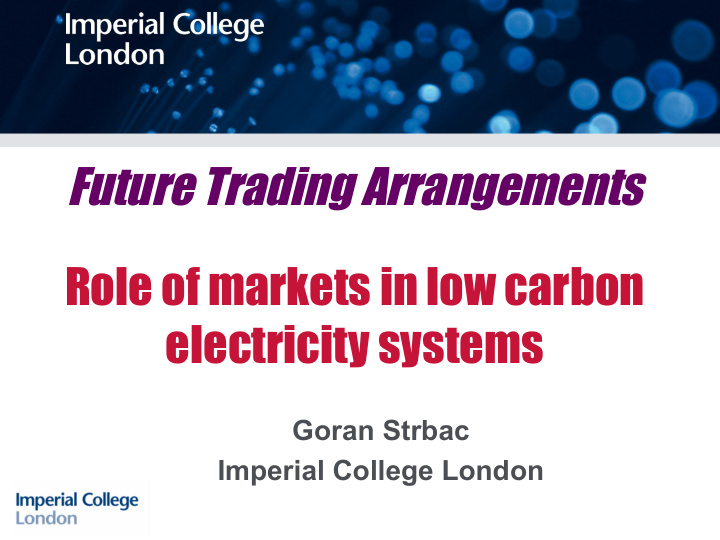



Future Trading Arrangements Role of markets in low carbon electricity systems Goran Strbac Imperial College London
Areas of interest • Synergies and conflicts between market and subsidies driven investment in low carbon energy system • Role of markets in supporting cost effective integration of low carbon generation and demand technologies • Innovative solutions and industry business model • Consumer interests • Building evidence - case studies • Value of DSR and generation flexibility, role of networks, benefits of EU market integration
UK Response to Climate Change Challenge 2008/09 TRANSMISSION SYSTEM - 2020: 25-30% of all electricity AS AT 31st DECEMBER 2007 400kV Substations 275kV Substations 132kV Substations 400kV Circuits 275kV Circuits 132kV Circuits demand to be met by renewable Major Generating Sites Including Pumped Storage Pentland Firth Connected at 400kV THE SHETLAND ISLANDS Connected at 275kV 6 Hydro Generation 1 generation - 2030+: 5 7 - Largely decarbonised electricity 2 8 9 10 4 generation, while…… 3 3 Tongland 2 2 14 1 4 - Electrifying segments of 3 1 4 2 3 17 9 16 15 4 transport and heat sectors 5 7 6 14 11 13 13 12 10 12 11 5 …in order to reduce CO2 9 10 8 7 6 9 5 8 emissions by 80% by 2050 6 7 3 3
Low carbon system integration challenge: degradation in asset utilization Asset Smart Network Utilisation Demand Flexible Balancing Technologies & Technologies Response Interconnection 55% Paradigm shift: from redundancy in assets to intelligent control Flexible 35% Storage Generation BaU Volume of the market 25% for flexible balancing technologies >£60b System integration costs in low carbon European system may 2010 2020 2030+ exceed € 500b 4
Balancing and Need for Flexibility Number of hours with zero or negative prices High ¡Genera+on ¡ Low ¡Genera+on ¡ Flexibility ¡ Flexibility ¡ 200 ¡ >1500 ¡ Unprecedented price volatility … . value of energy frequently lower than value of flexibility leading to increased base-load & peak generation investment risks... ...while providing significant opportunities for demand side response, storage, flexible generation and interconnection 5
Demand response in action: demand to follow wind … Smart Dishwasher Washing Machine & Refrigerator Air Conditioner Water Heater Tumble Drier Genera+on ¡Mix ¡Flexibility ¡ High ¡ ¡ Low ¡ Cost ¡Savings ¡£/SD ¡ <10 ¡ >100 ¡ CO 2 ¡Savings ¡kg/SD/year ¡ <50 ¡ >250 ¡
Complexity of demand response and storage: Split benefits Balancing Network services services Can the market facilitate this? How about DSR & industry business model?
Value of Flexible Peaking Plant – 2020+ GW 8 8
Impact of flexibility on plant energy production 9
UK ¡is ¡not ¡an ¡island ¡in ¡low ¡carbon ¡future ¡ UK-‑N ¡1.5GW ¡ UK-‑NI ¡1.5GW ¡ Import: ¡6.0 ¡TWh ¡ Import: ¡1.4 ¡TWh ¡ Export: ¡4.4 ¡TWh ¡ Export: ¡1.7 ¡TWh ¡ NO-‑S ¡ UK-‑S ¡1GW ¡ Import: ¡2.4 ¡TWh ¡ UK-‑N ¡ Export: ¡3.0 ¡TWh ¡ IR ¡ UK-‑S ¡ ¡13GW ¡ Import: ¡51 ¡TWh ¡ Export: ¡0.1 ¡TWh ¡ UK-‑S ¡ NL ¡ BE ¡ Fr-‑NW ¡ Fr-‑NE ¡ UK-‑S ¡ ¡6GW ¡ Import: ¡7.4 ¡TWh ¡ Export: ¡15.9 ¡TWh ¡ UK-‑S ¡ ¡6GW ¡ Import: ¡13.1 ¡TWh ¡ Export: ¡17.8 ¡TWh ¡ UK-‑S ¡ ¡1GW ¡ Import: ¡2.4 ¡TWh ¡ Export: ¡4.3 ¡TWh ¡
EU-wide versus member state centric RES deployment in Europe Coordinated new wind and new PV deployment à à saving 146 GW of new capacity - Wind in the North - PV in the South 11
EU-wide capacity mechanism can save 100-160 GW of peaking plant 206 Additional peaking capacity (GW) 92 48 103 0 11 17 65 0 Can you really Baseline Integrated Int Low TX Int Self-secure Int EU reserve Int DSR trust …… when it comes to security ? 12
Market design and regulatory framework Market design: • Market to facilitate consumer choice » Growing value of flexibility in future => energy bills of flexible consumers may be only 30% of these for inflexible consumers • Enable competition between smart and asset solutions Network design: • Cost-benefit approach to network operation and design • Recognition of smart technologies in network planning Regulation: • Incentivise application of flexible solutions against asset- based solutions • Split Benefits and business model
Future Trading Arrangements Role of markets in low carbon electricity systems Goran Strbac Imperial College London
Recommend
More recommend